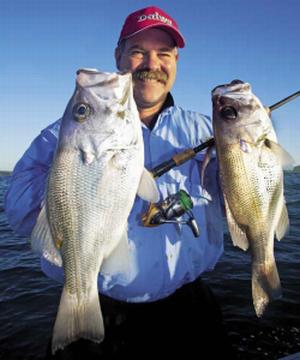ONE of the tastiest fish available to anglers fishing offshore on Australia’s east coast is the pearl perch (Glaucosoma scapulare).
Pearl perch, or pearlies as they’re commonly known, are one of four members of the pearl perch family (Glaucosomatidae) that occur in Australian waters. They can be easily distinguished from the three other closely related species by the fact they are the only ones that occur off Australia’s east coast.
Indeed, pearl perch are endemic to a relatively small area offshore from central and southern Queensland down to the central coast of NSW. In contrast, the deepsea jewfish (Glaucosoma buergeri) occurs off the Kimberley coast in Western Australia, as well as throughout SE Asia. The threadfin pearl perch (G. magnificum) is endemic to the Kimberley coast as well as offshore waters throughout the top end, including the Gulf of Carpentaria, while the famous (and much larger) WA Dhufish (G. hebraicum) is endemic to the west coast off WA.
All of these species live offshore near the bottom in waters up to 200 metres deep, mainly over rock ledges and rocky reefs and other bottom features such as cliffs and gutters. During the day they occur mainly in schools feeding on the bottom, but they can rise well off the bottom to feed in midwater at night.
Pearl perch are pretty, silvery coloured fish with large eyes and several brown longitudinal scale rows that are particularly prominent in juveniles.
They are so named because they have a very prominent grey/blue coloured bone (the supraclavical bone) that extends out on each side of the upper rear of the operculum. These bones have a thin layer of skin covering them, which when removed reveals the “pearl” in the form of the bone beneath, which is a brilliant pearly white. In contrast, they also have a faint “false eye” spot at the base of the rear of the dorsal fin, while inside the large mouth is often completely black.
Another interesting feature is at night some anglers have reported the inside of the mouth to appear slightly luminescent. This might be due to them feeding on salps or other bioluminescent prey at those times. Most of the time pearlies are voracious predators of smaller fish and invertebrates such as squid.

Fisho writer Dave Rae with a couple of pearlies destined for the dinner table.
Pearlies are a relatively large member of the Glaucosomatidae, second only to the WA dhufish in size with a maximum length of around 70cm and weight up to around 7.3 kg. Like other members of the family, they are relatively slow growing and long lived. It takes them two to four years to reach maturity at around 30cm long, while 50cm fish can be anywhere from four to nine years old. Maximum age is likely to exceed 20 years.
Because of their relatively slow growth and the advent of powerful sounders and GPS, this means that today it’s much easier to find (and return to) prime pearl perch habitat offshore than it was in the past, which means that populations of pearl perch are experiencing more fishing pressure. Management is in the form of bag and size limits, with the minimum sizes of 30cm in NSW and 35cm in QLD (bag limit of five in both states) being implemented in order to protect juvenile fish. These management methods mean that, in QLD, around 70 per cent of pearl perch captured by recreational anglers are released.
These management measures will protect pearl perch stocks only if undersized pearlies survive release, which may not necessarily be the case when they are taken from deep water offshore, due to depressurisation damage (barotrauma). Recent research in QLD has found that, fortunately, pearl perch are reasonably robust and can survive capture from depths that would be fatal for many other species of fish.
QLD Fisheries researchers found that their swim bladders rupture during ascent from depth, allowing swim bladder gases to escape into the gut cavity, after which the gas finds its way out the vent. This means that the internal organs are spared much of the damage that can occur if the gases cannot escape, resulting in post release survival rates of pearl perch around 90 per cent, even when being taken from depths over 80 metres.
The authors of the paper also found that the tears in the swim bladder began to heal quickly, within a few days, and that hooking location was the main predictor of mortality in pearl perch. Because of this, they recommended the use of circle hooks to reduce damage to undersized fish due to deep hooking. Using lures instead of bait can also generate the same effect and using jigs and plastics is indeed a fun way to target pearlies.
Even given these encouraging results, dragging undersized pearl perch from depths of 80 to 100 metres is still not ideal for their survival. Consequently, this species should not be considered a catch and release sportfishing target, and the usual mantra of taking only what you need is recommended, as is moving to a new spot when large numbers of undersized pearl perch are encountered.

















